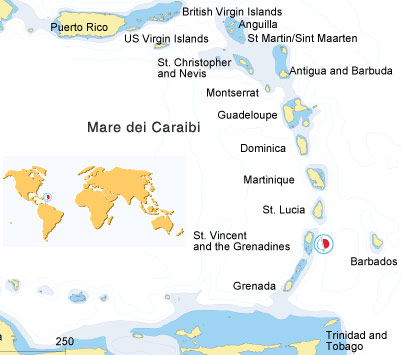USEFUL INFORMATION
Currency
In Martinique, French francs are used. The best exchange rates are offered by Change Caraibes in Fort de France. Some tourist stores offer a discount of up to 20% on purchases made with travellers checks. Currency used in the other islands is the “Eastern Caribbean Dollar” (EC) whose fixed value, corresponding to one american dollar, is 2.67 (euros??) Normally, banks will offer a better exchange rate than stores or taxis.
Tips
Everybody appreciates a tip, but nobody is counting on it. In restaurants, whenever gratuity is not included in the prices, it is customary to leave a 10% tip. If gratuity has been included, a little extra is appreciated but not obligatory.
Markets
All of the major islands have a market. Saturday morning is the best day, in Santa Lucia the market is on Friday.
Transport
There are taxis, county taxis (less expensive), busses and cars for rent. Make sure you always get a quote for the fee in EC dollars Before you take a taxi! Drivers have the bad habit of trying to confuse you with the two kinds of dollars. Some bargaining is possible on longer distances.
Bugs and dangerous plants
Normally, mosquitoes are not a problem on board, but sometimes when mooring near trees or in lagoons, leeward to larger islands, there may be many bugs. Bugs can also be found on beaches, especially on quiet nights during the rainy season (July to November). A more serious threat is the presence of a tree, Hippomane mancinella, which grows abundantly along the beaches. This lovely plant producing yellowish-green apple-like fruits is toxic. Its leaves can cause a serious skin rash accompanied by a fever. It is OK to sit in the shade of the tree, but absolutely avoid taking shelter under it in the rain, burning its leaves or branches in a fire, eating its fruits.
Fishing
Lobster season usually goes from October 1st to the end of April. During this period it is allowed to purchase these large crustaceans, but for the rest of the year purchasing lobsters (smaller than 23 cm) is forbidden. Lobsters with eggs cannot be bought at any time.
Customs
The Windward Islands include 4 different countries: Martinique; Santa Lucia; St. Vincent, including all of the Grenadines up to Petit St. Vincent; Grenada, including Carriacou and Petit Martinique. Each country has its own regulations and it is necessary to go through customs when leaving or reaching each island.
Special events
In Santa Lucia and Martinique, carnival traditionally takes place before Lent. Grenada and St. Vincent have festivities at different times, it is best to get information on the spot. In any case, carnival is a very important event everywhere, with major parades, marvellous costumes, calypso dances and steel-bands filling every street and plaza.
Sailing
An informal regatta takes place in Martinique at the beginning of April. It is called “Bananas Cup” and those wishing to participate can do so by contacting Puces Nautiques. If you happen to be in Martinique on July 14th, national festival day, you will witness several fun canoe competitions in Fort de France. “Aqua Action” takes place in in Santa Lucia, six weeks after Easter, on the day of Pentecost: it is a fantastic gala event with many international sport competitions. The Easter Regatta in Bequia is another event not to be missed. It includes competitions among yachts, local fishing boats, and several cultural events. Some of the most beautiful sailing boats of the islands (large and small fishing boats) can be admired in the Carriacou Regatta (taking place on the week-end previous to the first Monday in August).
Weather
There are two seasons, the dry and the rainy season, but they are not clearly defined. During the dry season (from February to June) the weather is usually sunny for weeks, with short light rain interludes. During the rainy season (from July to January) it is also mostly sunny, but rains are more frequent and occasionally lasting for a full day or longer. Winds are almost always north-easterly, blowing from 10 to 25 knots. Wind absence is rare. Hurricane season goes from June to October. Generally during the months of June, July and October a hurricane every 3 years forms over the western Atlantic Ocean, sometimes reaching the Caribbeans and the Gulf of Mexico. Hurricane frequency during the months of August and September is about 5 per year. Hurricanes form out in the middle of the Ocean, often at the latitude of the Windward Islands, then usually move northward and touch the higher Caribbean Islands. Only a few have ever touched the Windward Islands. Nowadays, hurricanes are predictable and their routes and development are closely monitored.
|

